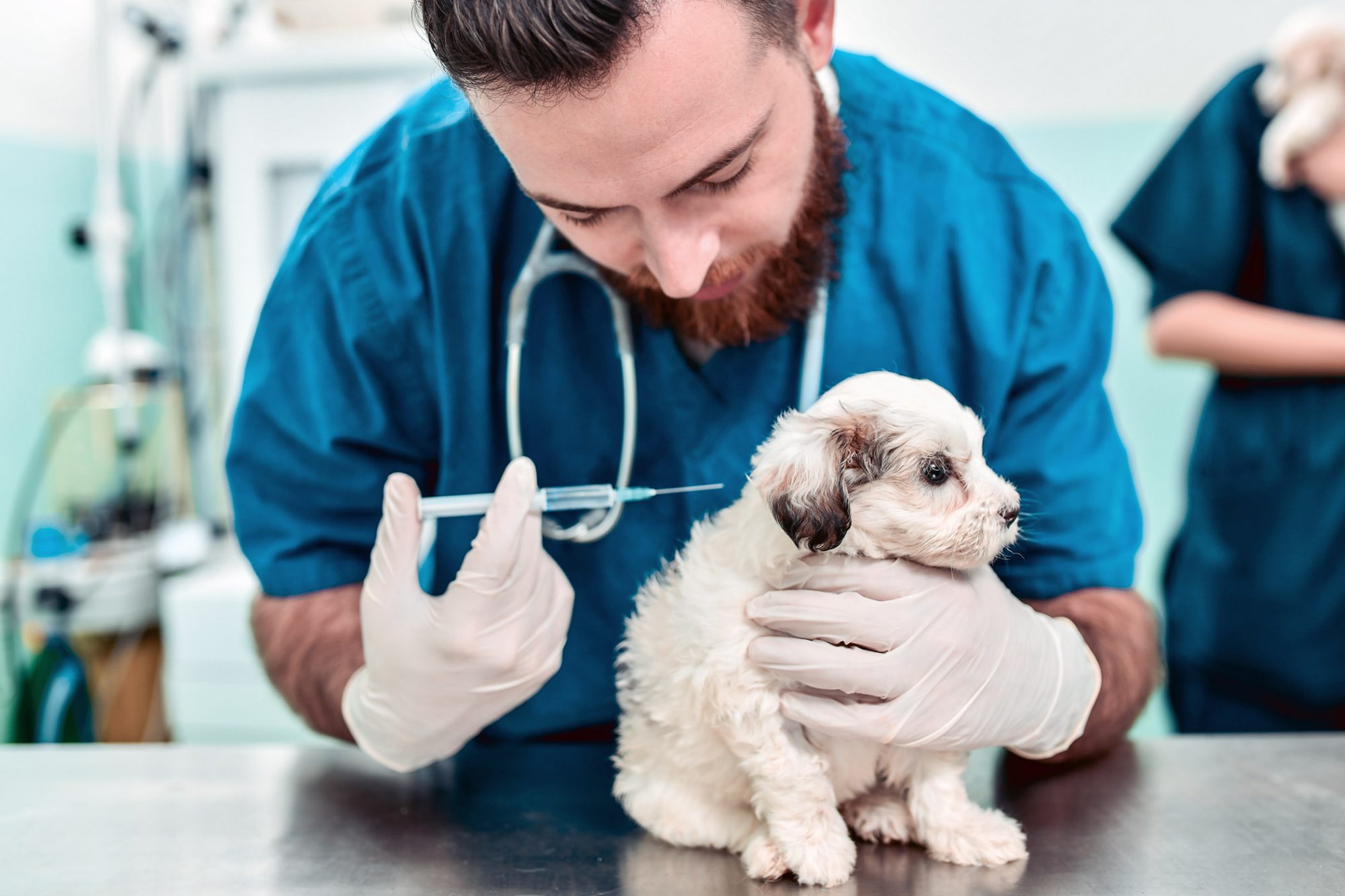Rabies is a deadly virus that can affect both animals and humans. Dogs, being one of the most common pets, are susceptible to rabies if not properly vaccinated. But how often should dogs get rabies shots? In this comprehensive guide, we’ll explore the recommended vaccination schedule, the science behind rabies immunity, and what to do if your dog encounters a potentially rabid animal.
Understanding Rabies and Its Risks

Rabies is a highly contagious viral disease that affects the central nervous system of mammals, including dogs and humans. It is caused by the rabies virus, which is typically transmitted through the saliva of infected animals, most commonly through a bite.
Transmission and Spread
When an infected animal bites another animal or human, the rabies virus is introduced into the body through the saliva. Once inside the body, the virus travels through the peripheral nerves to the brain and spinal cord, where it replicates rapidly. From there, it can spread to other organs and tissues, leading to severe neurological symptoms and ultimately death.
Symptoms and Progression
The symptoms of rabies in dogs typically progress in stages. Initially, there may be nonspecific signs such as fever, lethargy, and loss of appetite. As the disease progresses, dogs may exhibit neurological symptoms such as paralysis, aggression, and abnormal behavior. Eventually, dogs may experience difficulty swallowing, excessive salivation, and ultimately, respiratory failure.
High Fatality Rate
Rabies is almost invariably fatal once clinical symptoms appear. While there have been rare cases of survival, the disease is considered to have a nearly 100% fatality rate if left untreated. Prompt medical intervention, including post-exposure prophylaxis (PEP) with rabies vaccines and rabies immunoglobulin, is crucial to prevent the progression of the disease in humans.
Risks to Humans
Rabies is a zoonotic disease, meaning it can be transmitted from animals to humans. In areas where rabies is endemic, such as certain parts of Asia, Africa, and Latin America, dogs are the primary reservoirs of the virus and are responsible for the majority of human rabies cases. Human rabies cases are rare in countries with effective rabies control programs, but they still occur, often as a result of exposure to infected animals.
Public Health Concerns
Due to the significant public health risks associated with rabies, especially in areas where the virus is endemic, governments and health organizations prioritize rabies control and prevention efforts. This includes widespread vaccination of domestic animals, such as dogs and cats, as well as targeted control measures to reduce the prevalence of rabies in wildlife populations.
Importance of Rabies Vaccination for Dogs

Rabies vaccination for dogs is not just a recommendation but a critical step in ensuring the health and safety of both pets and humans. Let’s delve deeper into why rabies vaccination is so essential for dogs:
Prevention of Rabies Transmission
The primary purpose of vaccinating dogs against rabies is to prevent the transmission of the virus to other animals and humans. Dogs are one of the primary reservoirs for rabies virus transmission to humans, making them crucial targets for vaccination efforts. By vaccinating dogs, we can break the chain of transmission and reduce the risk of human exposure to the virus.
Legal Requirements
In many regions, rabies vaccination for dogs is not only strongly recommended but also legally mandated. State and local governments often have laws requiring dog owners to ensure their pets are up to date on their rabies vaccinations. Failure to comply with these laws can result in penalties and fines. Therefore, ensuring your dog receives regular rabies vaccinations is not only important for their health but also for legal compliance.
Protection of Individual Dogs
Rabies is a fatal disease with no cure once symptoms develop. Vaccination provides dogs with immunity against the rabies virus, protecting them from contracting the disease if they are exposed to an infected animal. This protection is essential for dogs that may come into contact with wildlife or other animals during outdoor activities or in areas where rabies is endemic.
Prevention of Wildlife Reservoirs
Unvaccinated dogs can serve as a source of rabies virus transmission to wildlife populations. By vaccinating dogs, we can help prevent the spread of rabies within wildlife populations, ultimately reducing the overall prevalence of the virus in the environment. This benefits not only dogs and humans but also other wildlife species susceptible to rabies.
Public Health Impact
Rabies is a significant public health concern globally, particularly in regions where the virus is endemic. Vaccinating dogs is a critical component of rabies control programs aimed at reducing the incidence of human rabies cases. By minimizing the risk of rabies transmission from dogs to humans, we can protect public health and save lives.
Overall Community Safety
Ensuring that a high proportion of dogs in a community are vaccinated against rabies contributes to overall community safety. Vaccination creates a barrier of immunity within the dog population, reducing the likelihood of rabies outbreaks and limiting the potential for human exposure to the virus. It fosters a safer environment for both pets and people to coexist.
Determining the Frequency of Rabies Shots

One-Year vs. Three-Year Vaccines
Traditionally, rabies vaccines for dogs were administered annually. However, advancements in vaccine technology have led to the development of three-year vaccines, which provide protection against rabies for a longer duration. The choice between a one-year and three-year vaccine often depends on factors such as the dog’s age, health status, and lifestyle.
- One-Year Vaccines: These vaccines require annual administration to maintain immunity against rabies. They are typically recommended for puppies and dogs receiving their initial rabies vaccinations.
- Three-Year Vaccines: These vaccines provide protection against rabies for up to three years after administration. They are suitable for adult dogs with a history of regular rabies vaccinations and are often preferred due to their longer duration of immunity.
State Regulations and Guidelines
While the availability of three-year vaccines has extended the interval between rabies shots, state regulations play a significant role in determining the vaccination schedule for dogs. Many states adhere to guidelines set forth by organizations such as the National Association of State Public Health Veterinarians (NASPHV) or the U.S. Department of Agriculture (USDA). These guidelines may recommend three-year vaccines for adult dogs and specify the acceptable intervals between vaccinations.
- Legal Requirements: State laws may mandate the frequency of rabies vaccinations for dogs, specifying whether annual or triennial vaccinations are required. Failure to comply with these laws may result in penalties for dog owners.
- Acceptance of Three-Year Vaccines: Fortunately, most states accept the use of three-year vaccines for rabies vaccination compliance. This acknowledgment reflects the effectiveness and safety of these vaccines in providing long-term immunity against rabies.
Individual Health Considerations
- Age: Puppies typically receive their first rabies vaccination at around 14 to 16 weeks of age, followed by a booster shot one year later. Subsequent vaccinations may follow either an annual or three-year schedule, depending on the vaccine type and state regulations.
- Health Status: Dogs with certain health conditions or compromised immune systems may require a customized vaccination schedule determined in consultation with a veterinarian. Additionally, dogs with a history of adverse reactions to vaccines may need special considerations when determining the frequency of rabies shots.
- Lifestyle and Exposure Risk: Dogs that frequently interact with wildlife or live in areas where rabies is prevalent may be at higher risk of exposure to the virus. In such cases, veterinarians may recommend more frequent vaccinations or additional preventive measures to ensure adequate protection against rabies.
Consultation with a Veterinarian
Ultimately, the determination of the frequency of rabies shots for a particular dog should be made in consultation with a licensed veterinarian. Veterinarians have the expertise to assess individual risk factors, recommend appropriate vaccination schedules, and ensure compliance with state regulations. Dog owners should prioritize regular veterinary visits and open communication with their veterinarians to maintain their pets’ health and well-being.
The Science Behind Rabies Immunity

Duration of Immunity
Research has shown that rabies vaccines stimulate the immune system to produce antibodies that recognize and neutralize the rabies virus. These antibodies provide protection against future exposure to the virus by preventing its replication and spread within the body. Initially, rabies vaccines were administered annually to ensure continuous immunity. However, studies have demonstrated that the duration of immunity provided by rabies vaccines can extend beyond one year, paving the way for the development of longer-lasting vaccination schedules.
Extended Immunity Studies
The Rabies Challenge Fund Research Study, led by esteemed researcher W. Jean Dodds, DVM, sought to determine the duration of immunity provided by rabies vaccines. This groundbreaking study aimed to evaluate whether rabies booster intervals could be extended to five or seven years while still maintaining adequate protection against the virus. The findings of this study have significant implications for rabies vaccination protocols and have sparked discussions about the possibility of reducing the frequency of rabies shots without compromising immunity.
Immunological Memory
One of the key findings of the Rabies Challenge Fund Research Study is the presence of immunological memory in vaccinated dogs. Immunological memory refers to the ability of the immune system to recognize and mount a rapid response to a previously encountered pathogen. Even in vaccinated dogs with low levels of circulating antibodies, the immune system retains memory of the rabies virus, allowing for a swift and effective immune response upon re-exposure. This phenomenon highlights the robustness and durability of rabies immunity induced by vaccination.
Vaccine-related Adverse Events
While rabies vaccines are generally safe and well-tolerated by most dogs, there is a small risk of vaccine-related adverse events. These adverse events may range from mild reactions such as soreness at the injection site to more severe allergic reactions or immune-mediated disorders. The Rabies Challenge Fund Research Study also aimed to assess the safety of extended rabies booster intervals and evaluate the risk of vaccine-related adverse events associated with prolonged vaccination schedules.
Future Research Directions
While the findings of the Rabies Challenge Fund Research Study provide valuable insights into the duration and durability of rabies immunity, further research is needed to fully elucidate the intricacies of rabies vaccine-induced immunity. Future studies may focus on optimizing vaccination protocols, evaluating alternative vaccine formulations, and investigating novel vaccine delivery methods to enhance the effectiveness and safety of rabies vaccination programs.
Special Considerations for Rabies Vaccination

Dogs with Adverse Reactions
Some dogs may experience adverse reactions to rabies vaccines, ranging from mild discomfort at the injection site to severe allergic reactions. These reactions can be distressing for both the dog and the owner and may necessitate special precautions when administering future vaccinations.
- Identifying High-Risk Individuals: Certain dog breeds or individuals with a history of vaccine-related adverse events may be at higher risk of experiencing reactions to rabies vaccines. It’s essential for veterinarians to carefully evaluate each dog’s medical history and assess their risk factors before administering vaccinations.
- Alternative Vaccination Schedules: For dogs with a documented history of adverse reactions to rabies vaccines, veterinarians may recommend alternative vaccination schedules or modified vaccine formulations to minimize the risk of recurrence. This may include premedication with antihistamines or corticosteroids to mitigate potential allergic reactions.
Waivers and Exemptions
In some cases, dogs may be eligible for waivers or exemptions from rabies vaccination requirements due to medical reasons or documented adverse reactions. These waivers allow dog owners to legally opt out of rabies vaccination mandates while still complying with state regulations.
- Consultation with Veterinarians: Obtaining a waiver for rabies vaccination typically requires consultation with a licensed veterinarian, who can assess the dog’s medical history, evaluate the risk of rabies exposure, and provide supporting documentation to justify the exemption request.
- State Regulations: The availability of waivers for rabies vaccination varies depending on state regulations. Some states may have specific criteria for granting waivers, while others may require approval from public health authorities or regulatory agencies.
Considerations for Immunocompromised Dogs
Dogs with compromised immune systems, such as those undergoing chemotherapy or receiving immunosuppressive medications, may require special considerations when it comes to rabies vaccination. These dogs may have reduced ability to mount an effective immune response to vaccines, increasing their susceptibility to infectious diseases.
- Individualized Vaccination Plans: Veterinarians may recommend individualized vaccination plans for immunocompromised dogs, taking into account factors such as the severity of immunosuppression, underlying medical conditions, and the risk of rabies exposure.
- Monitoring for Vaccine Response: Close monitoring for adverse reactions or vaccine failures is essential for immunocompromised dogs receiving rabies vaccines. Veterinarians may recommend periodic antibody titers or other tests to assess vaccine efficacy and ensure adequate protection against rabies.
Ethical Considerations
In cases where rabies vaccination poses a significant risk to the dog’s health or well-being, ethical considerations may come into play. Dog owners and veterinarians must balance the need for rabies protection with the potential risks and benefits of vaccination, taking into account factors such as the dog’s quality of life and overall health status.
- Informed Decision-Making: Dog owners should be fully informed about the risks and benefits of rabies vaccination and actively participate in decision-making regarding their pet’s health care. Open communication with veterinarians and consideration of individual circumstances are essential for making ethically sound choices regarding rabies vaccination.
What to Do If Your Dog Encounters a Rabid Animal

Immediate Response
- Remove Your Dog from the Situation: If your dog encounters a rabid animal, such as a raccoon, skunk, fox, or bat, immediately remove your dog from the area to prevent further exposure to the potentially rabid animal.
- Avoid Direct Contact: Do not attempt to physically intervene or handle the rabid animal yourself. Direct contact with the saliva or bodily fluids of an infected animal can transmit the rabies virus to humans and animals.
- Contact Animal Control: Notify your local animal control authorities or wildlife management agency as soon as possible to report the incident. They can dispatch trained professionals to safely capture or euthanize the rabid animal and prevent further spread of the virus.
Veterinary Consultation
- Seek Veterinary Advice: After encountering a potentially rabid animal, consult with your veterinarian immediately to assess the risk of rabies exposure to your dog. Your veterinarian can provide guidance on whether your dog requires post-exposure rabies prophylaxis, including rabies vaccination and observation.
- Rabies Vaccination: If your dog is not up to date on its rabies vaccination, your veterinarian may recommend administering a rabies vaccine booster as a precautionary measure. Rabies vaccination is the most effective way to prevent the development of rabies in dogs exposed to the virus.
Quarantine and Observation
- Quarantine Protocol: Depending on the circumstances of the encounter and your dog’s vaccination status, your veterinarian may recommend placing your dog under quarantine for observation. Quarantine periods typically last for a specified duration to monitor for signs of rabies infection.
- Observation Period: During the quarantine period, closely monitor your dog for any abnormal behaviors or symptoms indicative of rabies, such as changes in temperament, excessive salivation, difficulty swallowing, or paralysis. Report any concerning signs to your veterinarian immediately.
Public Health Measures
- Public Health Reporting: In cases where rabies exposure poses a risk to public health, local public health authorities may implement additional measures to prevent the spread of the virus. This may include notifying individuals who may have been exposed to the rabid animal and providing guidance on seeking medical attention.
- Compliance with Regulations: Follow any additional recommendations or requirements issued by public health authorities or regulatory agencies regarding rabies exposure management and reporting. Compliance with these regulations is essential for protecting public health and preventing further transmission of the virus.
Conclusion
Ensuring that your dog receives regular rabies vaccinations is essential for protecting their health and preventing the spread of rabies. By understanding the recommended vaccination schedule, state regulations, and the science behind rabies immunity, dog owners can take proactive steps to safeguard their pets and their communities against this deadly disease. Always consult with your veterinarian to determine the best vaccination plan for your dog based on individual factors and local requirements.

